Microsoft CEO Satya Nadella says the Surface line is here to stay. But are changes coming to the company's device strategy?


Windows 10: 11 Big Changes
Windows 10: 11 Big Changes (Click image for larger view and slideshow.)
Microsoft CEO Satya Nadella said this week that Microsoft is committed to its Surface products. Why was the clarification necessary? Microsoft introduced its first Surface tablet in fall 2012 and ever since, critics have been pointing out reasons the company should stop making devices.
Disastrous early sales gave Surface detractors plenty of ammunition, for example. Those sales have gradually improved -- but not enough for Microsoft to actually disclose sales numbers. Without strong sales figures to appease concerns, some Microsoft critics have dismissed the tablets as ill-advised Apple envy. These critics, who have reportedly included influential Microsoft shareholders, fear that devices eat up resources that Microsoft could more profitably allocate to high-margin enterprise software efforts.
The well-received Surface Pro 3, though nowhere near an iPad-level success, has quieted some of the criticism. So has Nadella. Whereas previous CEO Steve Ballmer positioned devices as a core pillar in Microsoft's strategy, Nadella has emphasized that productivity platforms and cloud products define his vision, with products such as the Surface playing a supporting role.
But how big a role? Nadella terminated the Surface Mini that the company had planned to announce alongside the Surface Pro 3, raising questions about the Surface line's long-term direction. Recent supply chain rumors claimed Microsoft might shut down its first-party tablet efforts, and though Microsoft said Thursday that this won't be the case, many questions remain.
What do we know about the future of Microsoft's tablet efforts? Here are five facts.
1. The Surface line has Nadella's full support.
In a blog post, Nadella said, "Microsoft is putting its full and sustained support behind the ongoing Surface program as one of a number of great hardware choices for businesses large and small." Its notable Nadella mentioned the Surface as one option among many "great" choices -- language that not only reflects the Surface line's "supporting role" within the company, but also suggests Microsoft wants to avoid the impression that it's competing with its own hardware partners, such as Dell and Lenovo.
2. Surface Pro 3 accessories will work with the next-gen Pro device.
According to the blog post, the next-gen Surface Pro will be compatible with almost all of the Surface Pro 3 accessories available today: Type Cover keyboards, power adapters, Ethernet adapters, and other "infrastructure" accessories, and the Surface Pro 3 Docking Station. According to Microsoft, this means businesses can invest in Surface Pro products without worrying about support issues down the road. It also indicates that future Surface Pro models will share the Pro 3's 12-inch display size -- though in typically secretive fashion, Microsoft reps declined to confirm that this will be the case.
3. Surface Pro tablets will be compatible with Windows 10.
Nadella's blog post mentioned that Surface Pro 3 will be fully compatible with Windows 10. In an interview, Surface Director Cyril Belikoff told InformationWeek older Pro models will be upgradable to Windows 10 too. The outlook for non-Pro Surfaces is less clear, however (see next item).
4. ARM-based Surfaces might be axed.
Microsoft has confirmed ongoing support for its Surface Pro models, but company reps have been much cagier when asked about the ARM-based Surface products -- the original Surface RT, and its follow-up, the Surface 2. Some online reports suggest Microsoft might be working on additional ARM-based Surface tablets, but at least one rumor indicates the company will focus on Intel-based Surface models going forward. If Microsoft doesn't update the year-old Surface 2 ahead of the coming holiday season, the inaction would certainly raise questions about the company's ongoing commitment to ARM tablets.
Microsoft has struggled to convince other manufacturers to invest in ARM-based Surface tablets, which lack the full compatibility with desktop apps offered by Intel-based models. Some Windows 10-based smartphones will presumably use ARM chips, but it's unclear what that means for next-gen Windows tablets, let alone Surface models in particular. Last month, Microsoft execs previewed Windows 10's enterprise-oriented features and promised to reveal the OS's consumer versions in coming months. The company's plans for ARM-based Windows devices should come into sharper focus by then.
5. Optimized Surface apps are finally appearing.
Microsoft recently revealed that half of its corporate Surface Pro 3 customers purchase the device with its docking station. This arguably speaks to the device's utility as a laptop or desktop-replacement -- but what about its tablet mode? Microsoft has pitched 2-in-1 use cases since its Surface tablets hit the market, but because of a dearth of compelling touch apps, the hybrid model hasn't yet broken out. That could be changing, though. Earlier this month, Adobe and Microsoft showed off versions of Adobe's Creative Cloud apps that have been optimized for use with the Surface Pro 3, for example.
The changes don't merely apply touch sensitivity to Adobe's traditional UI; rather, Adobe, with input from Microsoft, rebuilt the apps from the ground-up, meaning customers will be able to use either the familiar mouse-and-keyboard UI or a completely new interface built for touchscreens.
The Internet of Things demands reliable connectivity, but standards remain up in the air. Here's how to kick your IoT strategy into high gear. Get the new IoT Goes Mobile issue of InformationWeek Tech Digest today. (Free registration required.)
About the Author(s)
You May Also Like







